brake fluid TOYOTA GR86 2022 Owners Manual (in English)
[x] Cancel search | Manufacturer: TOYOTA, Model Year: 2022, Model line: GR86, Model: TOYOTA GR86 2022Pages: 582, PDF Size: 86.38 MB
Page 16 of 582

14Pictorial index
Parking brake .................................................................................P.151
Applying/releasing............................................................................P.151
Precautions for winter season..........................................................P.261
Warning lights ..................................................................................P.336
Headlight switch ...........................................................................P.153
Turn signal lever ............................................................................P.150
Headlights/front position lights/tail lights/daytime running lights ......P.153
Rear fog light....................................................................................P.159
Windshield wiper and washer switch ..........................................P.160
Usage...............................................................................................P.160
Adding washer fluid..........................................................................P.300
Headlight cleaners ...........................................................................P.160
Emergency flasher switch.............................................................P.326
Hood lock release lever .................................................................P.293
Tilt and telescopic steering lock release lever ............................P.122
Adjustment .......................................................................................P.122
Air conditioning system ................................................................P.264
Usage...............................................................................................P.264
Rear window defogger .....................................................................P.266
Audio system*2
*1: Vehicles with an automatic transmission
*2: Refer to “Multimedia owner’s manual”.
Page 22 of 582
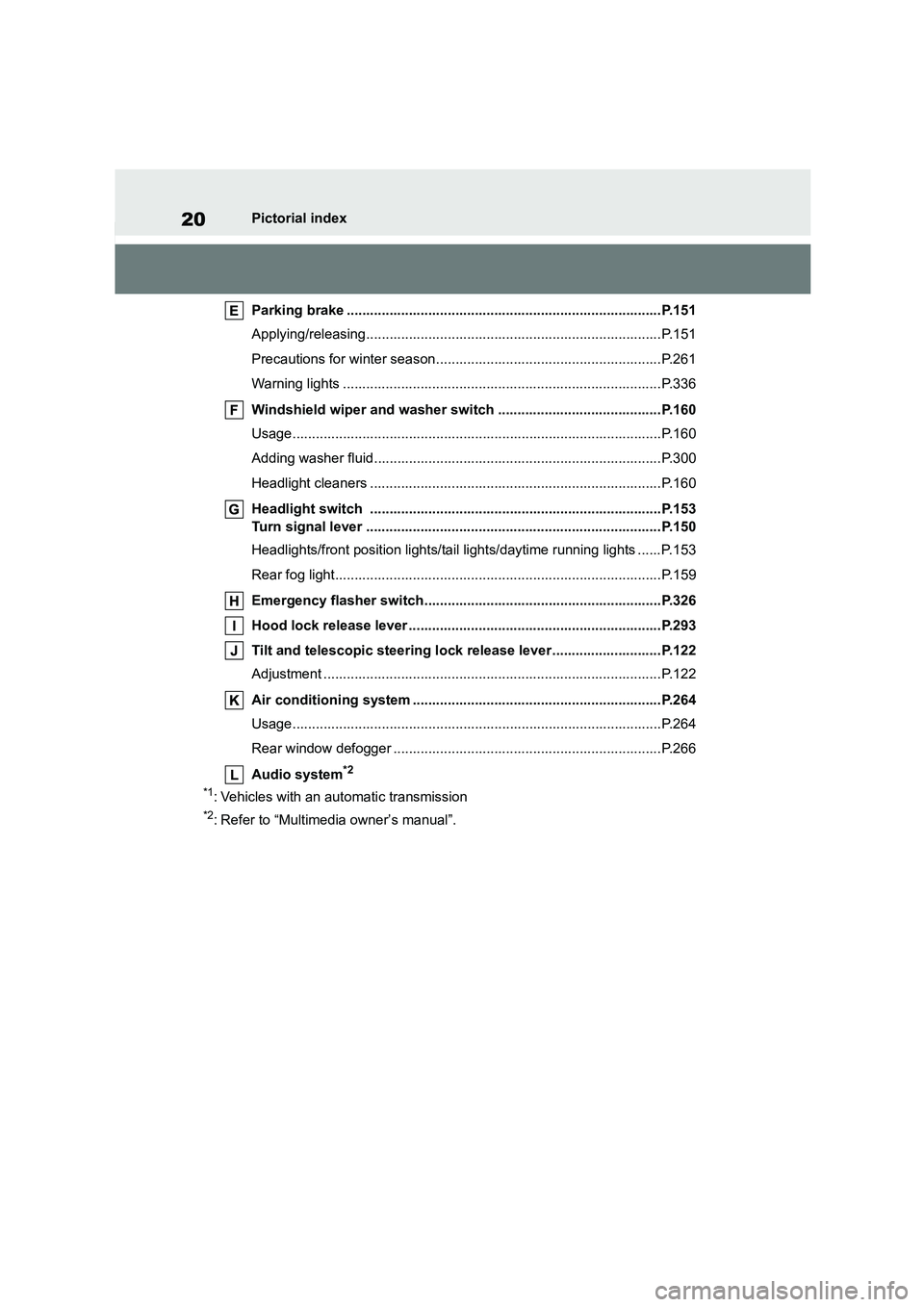
20Pictorial index
Parking brake .................................................................................P.151
Applying/releasing............................................................................P.151
Precautions for winter season..........................................................P.261
Warning lights ..................................................................................P.336
Windshield wiper and washer switch ..........................................P.160
Usage...............................................................................................P.160
Adding washer fluid..........................................................................P.300
Headlight cleaners ...........................................................................P.160
Headlight switch ...........................................................................P.153
Turn signal lever ............................................................................P.150
Headlights/front position lights/tail lights/daytime running lights ......P.153
Rear fog light....................................................................................P.159
Emergency flasher switch.............................................................P.326
Hood lock release lever .................................................................P.293
Tilt and telescopic steering lock release lever ............................P.122
Adjustment .......................................................................................P.122
Air conditioning system ................................................................P.264
Usage...............................................................................................P.264
Rear window defogger .....................................................................P.266
Audio system*2
*1: Vehicles with an automatic transmission
*2: Refer to “Multimedia owner’s manual”.
Page 97 of 582
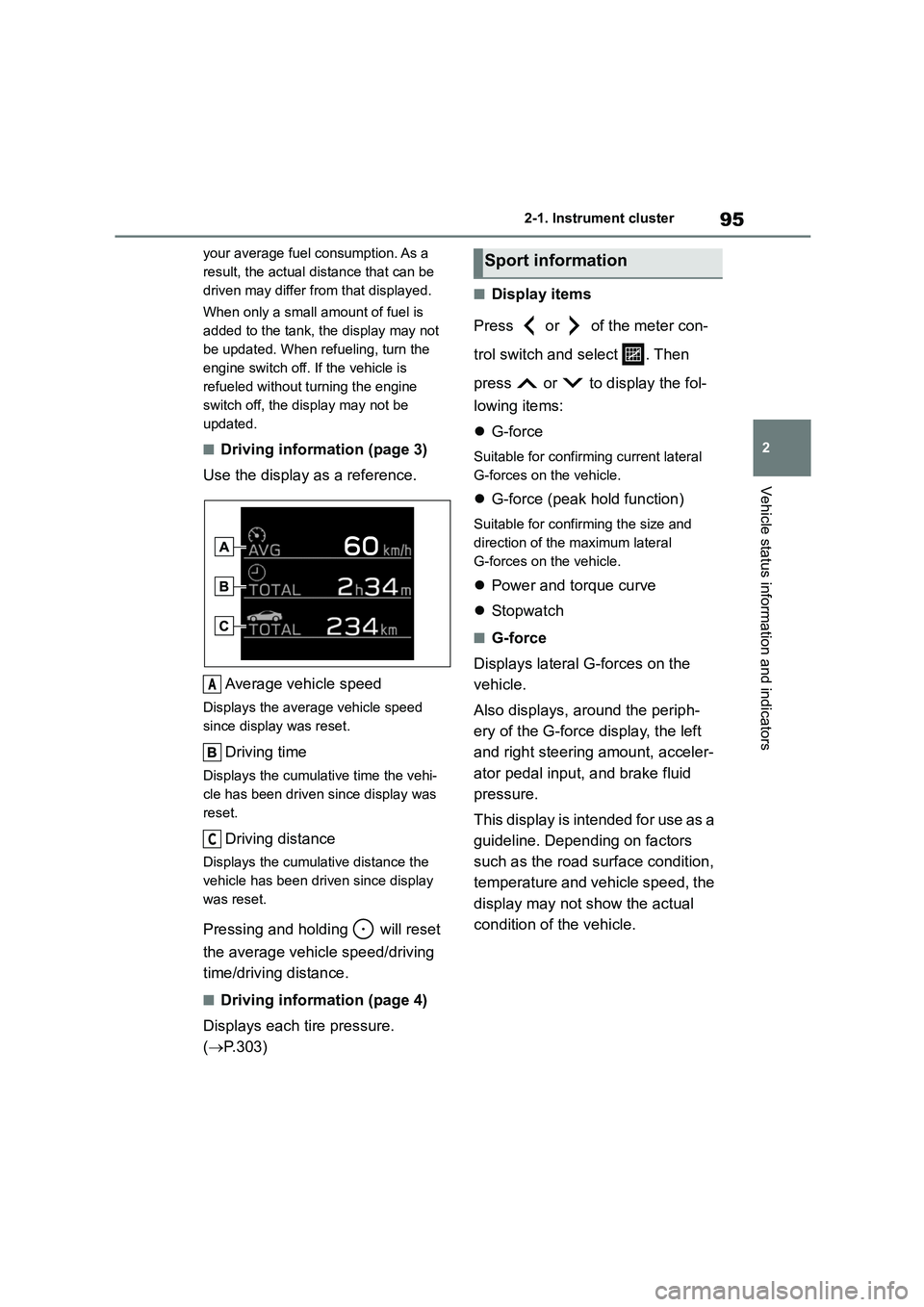
95
2
2-1. Instrument cluster
Vehicle status information and indicators
your average fuel consumption. As a
result, the actual distance that can be
driven may differ from that displayed.
When only a small amount of fuel is
added to the tank, the display may not
be updated. When refueling, turn the
engine switch off. If the vehicle is
refueled without turning the engine
switch off, the display may not be
updated.
■Driving information (page 3)
Use the display as a reference.
Average vehicle speed
Displays the average vehicle speed
since display was reset.
Driving time
Displays the cumulative time the vehi-
cle has been driven since display was
reset.
Driving distance
Displays the cumulative distance the
vehicle has been driven since display
was reset.
Pressing and hold ing will reset
the average vehicle speed/driving
time/driving distance.
■Driving information (page 4)
Displays each tire pressure.
( P.303)
■Display items
Press or of the meter con-
trol switch and select . Then
press or to display the fol-
lowing items:
G-force
Suitable for confirming current lateral
G-forces on the vehicle.
G-force (peak hold function)
Suitable for confirming the size and
direction of the maximum lateral
G-forces on the vehicle.
Power and torque curve
Stopwatch
■G-force
Displays lateral G-forces on the
vehicle.
Also displays, around the periph-
ery of the G-force display, the left
and right steering amount, acceler-
ator pedal input, and brake fluid
pressure.
This display is intended for use as a
guideline. Depending on factors
such as the road surface condition,
temperature and vehicle speed, the
display may not show the actual
condition of the vehicle.
A
C
Sport information
Page 98 of 582
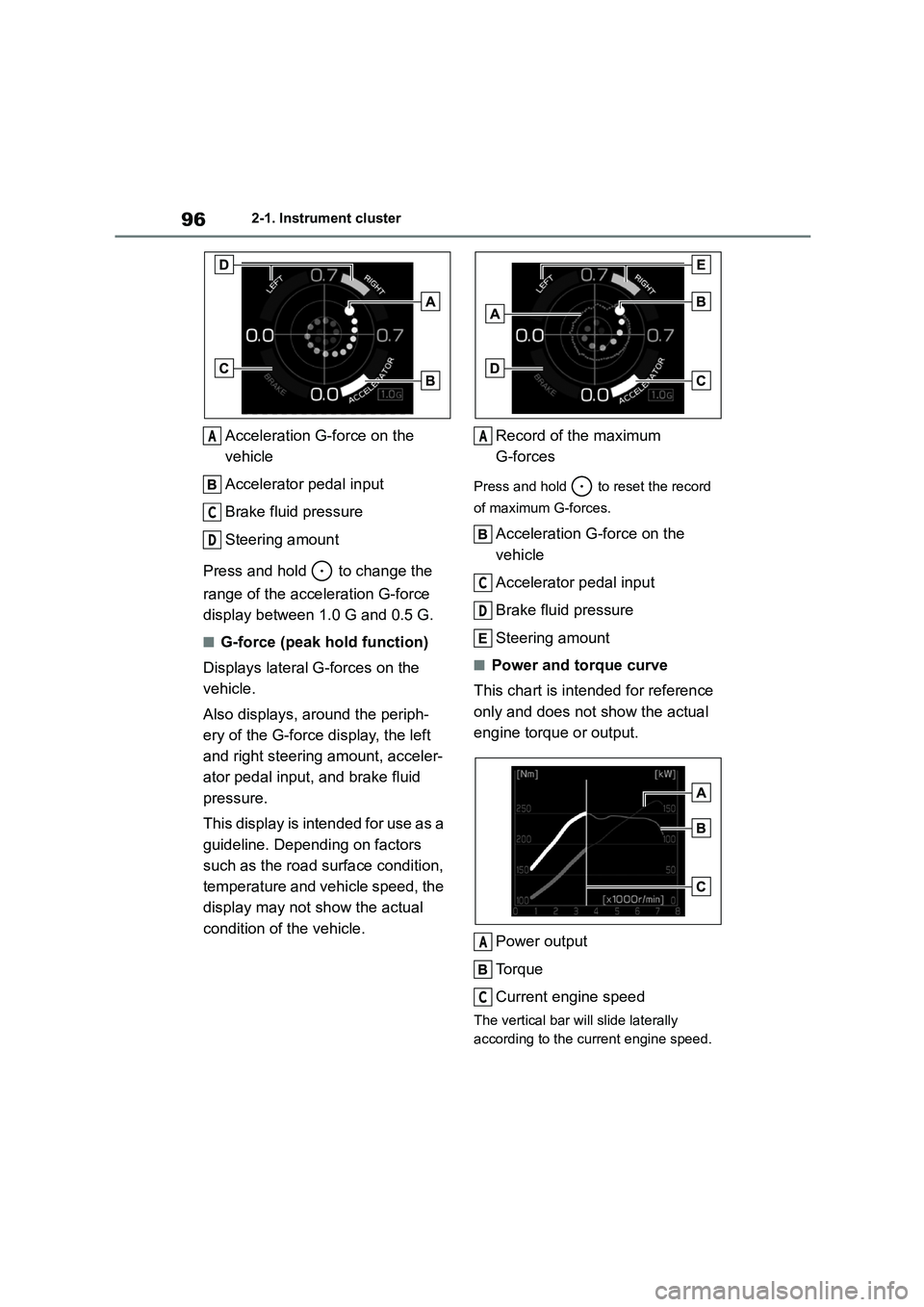
962-1. Instrument cluster
Acceleration G-force on the
vehicle
Accelerator pedal input
Brake fluid pressure
Steering amount
Press and hold to change the
range of the acceleration G-force
display between 1.0 G and 0.5 G.
■G-force (peak hold function)
Displays lateral G-forces on the
vehicle.
Also displays, around the periph-
ery of the G-force display, the left
and right steering amount, acceler-
ator pedal input, and brake fluid
pressure.
This display is intended for use as a
guideline. Depending on factors
such as the road surface condition,
temperature and vehicle speed, the
display may not show the actual
condition of the vehicle.
Record of the maximum
G-forces
Press and hold to reset the record
of maximum G-forces.
Acceleration G-force on the
vehicle
Accelerator pedal input
Brake fluid pressure
Steering amount
■Power and torque curve
This chart is intended for reference
only and does not show the actual
engine torque or output.
Power output
To r q u e
Current engine speed
The vertical bar will slide laterally
according to the current engine speed.
A
C
D
A
C
D
A
C
Page 138 of 582
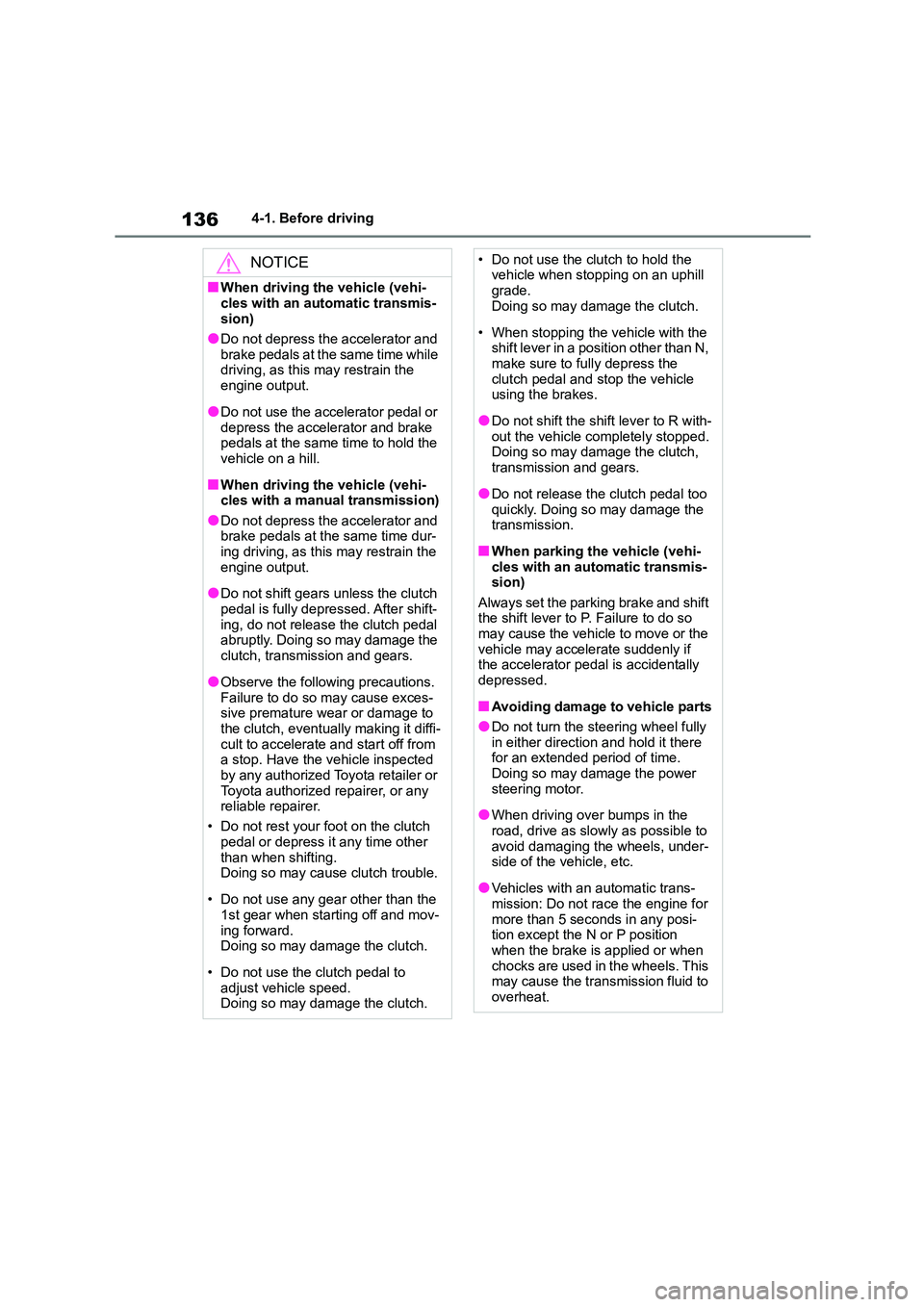
1364-1. Before driving
NOTICE
■When driving the vehicle (vehi-
cles with an automatic transmis-
sion)
●Do not depress the accelerator and
brake pedals at the same time while
driving, as this may restrain the engine output.
●Do not use the accelerator pedal or
depress the accelerator and brake pedals at the same time to hold the
vehicle on a hill.
■When driving the vehicle (vehi-
cles with a manual transmission)
●Do not depress the accelerator and brake pedals at the same time dur-
ing driving, as this may restrain the
engine output.
●Do not shift gears unless the clutch
pedal is fully depressed. After shift- ing, do not release the clutch pedal
abruptly. Doing so may damage the
clutch, transmission and gears.
●Observe the following precautions.
Failure to do so may cause exces- sive premature wear or damage to
the clutch, eventually making it diffi-
cult to accelerate and start off from a stop. Have the vehicle inspected
by any authorized Toyota retailer or
Toyota authorized repairer, or any reliable repairer.
• Do not rest your foot on the clutch
pedal or depress it any time other than when shifting.
Doing so may cause clutch trouble.
• Do not use any gear other than the
1st gear when starting off and mov-
ing forward. Doing so may damage the clutch.
• Do not use the clutch pedal to adjust vehicle speed.
Doing so may damage the clutch.
• Do not use the clutch to hold the vehicle when stopping on an uphill
grade.
Doing so may damage the clutch.
• When stopping the vehicle with the
shift lever in a position other than N, make sure to fully depress the
clutch pedal and stop the vehicle
using the brakes.
●Do not shift the shift lever to R with-
out the vehicle completely stopped. Doing so may damage the clutch,
transmission and gears.
●Do not release the clutch pedal too
quickly. Doing so may damage the
transmission.
■When parking the vehicle (vehi-
cles with an automatic transmis- sion)
Always set the parking brake and shift
the shift lever to P. Failure to do so may cause the vehicl e to move or the
vehicle may accelerate suddenly if
the accelerator pedal is accidentally depressed.
■Avoiding damage to vehicle parts
●Do not turn the steering wheel fully
in either direction and hold it there
for an extended period of time. Doing so may damage the power
steering motor.
●When driving over bumps in the
road, drive as slowly as possible to
avoid damaging the wheels, under- side of the vehicle, etc.
●Vehicles with an automatic trans-mission: Do not race the engine for
more than 5 seconds in any posi-
tion except the N or P position
when the brake is applied or when chocks are used in the wheels. This
may cause the transmission fluid to
overheat.
Page 139 of 582
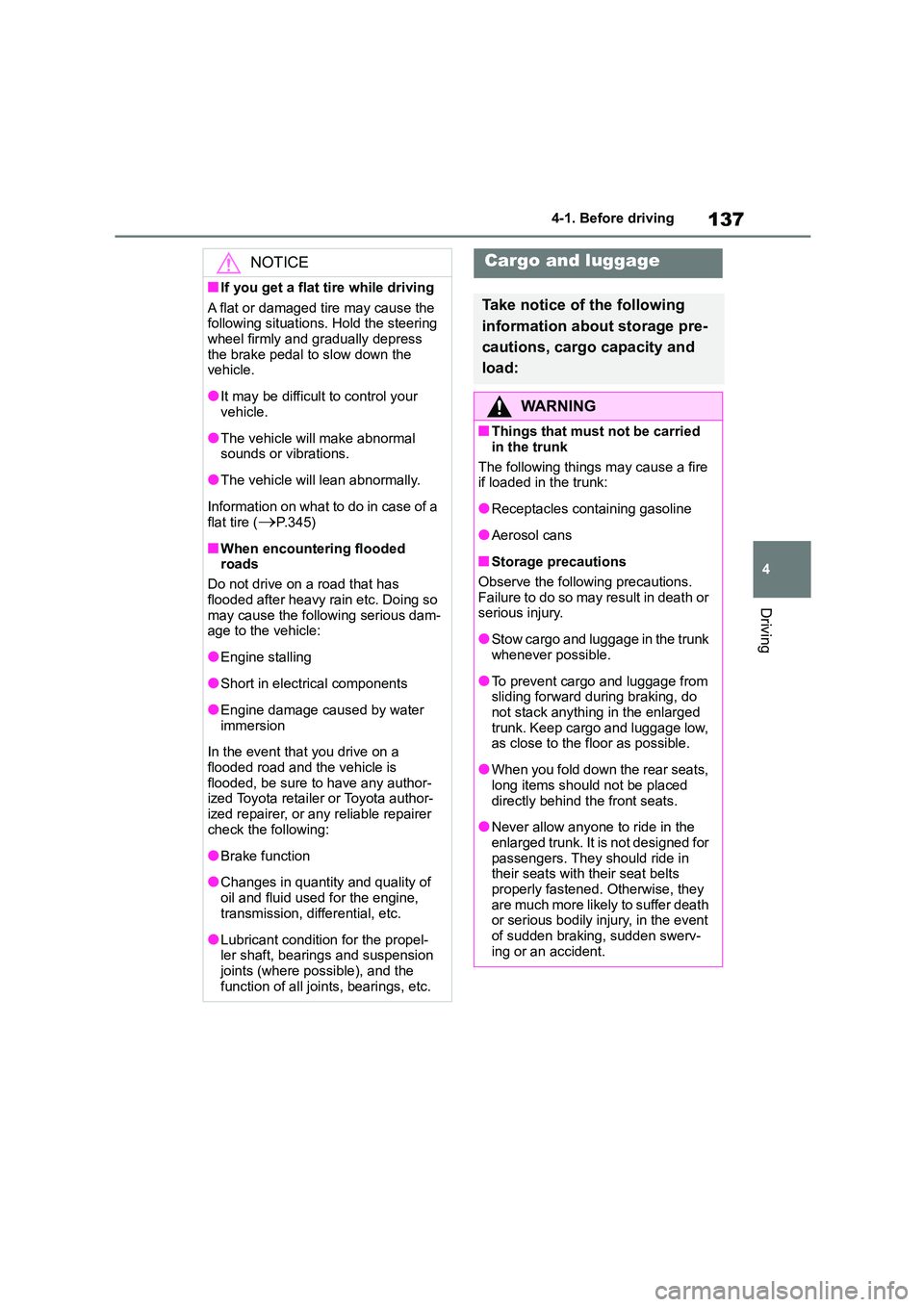
137
4
4-1. Before driving
Driving
NOTICE
■If you get a flat tire while driving
A flat or damaged tire may cause the
following situations. Hold the steering wheel firmly and gradually depress
the brake pedal to slow down the
vehicle.
●It may be difficult to control your
vehicle.
●The vehicle will make abnormal
sounds or vibrations.
●The vehicle will lean abnormally.
Information on what to do in case of a flat tire (P.345)
■When encountering flooded roads
Do not drive on a road that has
flooded after heavy rain etc. Doing so may cause the following serious dam-
age to the vehicle:
●Engine stalling
●Short in electrical components
●Engine damage caused by water
immersion
In the event that you drive on a
flooded road and the vehicle is flooded, be sure to have any author-
ized Toyota retailer or Toyota author-
ized repairer, or any reliable repairer check the following:
●Brake function
●Changes in quantity and quality of
oil and fluid used for the engine, transmission, differential, etc.
●Lubricant condition for the propel-ler shaft, bearings and suspension
joints (where possible), and the
function of all joints, bearings, etc.
Cargo and luggage
Take notice of the following
information about storage pre-
cautions, cargo capacity and
load:
WA R N I N G
■Things that must not be carried
in the trunk
The following things may cause a fire if loaded in the trunk:
●Receptacles containing gasoline
●Aerosol cans
■Storage precautions
Observe the following precautions.
Failure to do so may result in death or serious injury.
●Stow cargo and luggage in the trunk whenever possible.
●To prevent cargo and luggage from sliding forward during braking, do
not stack anything in the enlarged
trunk. Keep cargo and luggage low, as close to the floor as possible.
●When you fold down the rear seats, long items should not be placed
directly behind the front seats.
●Never allow anyone to ride in the
enlarged trunk. It is not designed for
passengers. They should ride in their seats with their seat belts
properly fastened. Otherwise, they
are much more likely to suffer death or serious bodily injury, in the event
of sudden braking, sudden swerv-
ing or an accident.
Page 292 of 582

2906-2. Maintenance
request that a record of maintenance
be kept.
■Does your vehicle need repairs?
Be on the alert for changes in perfor- mance and sounds, and visual tip-offs
that indicate service is needed. Some
important clues are:
●Engine missing, stumbling or pinging
●Appreciable loss of power
●Strange engine noises
●A fluid leak under the vehicle (How-
ever, water dripping from the air con- ditioning system after use is normal.)
●Change in exhaust sound (This may indicate a dangerous carbon monox-
ide leak. Drive with the windows open
and have the exhaust system checked immediately.)
●Flat-looking tires, excessive tire squeal when cornering, uneven tire
wear
●Vehicle pulls to one side when driven
straight on a level road
●Strange noises related to suspension
movement
●Loss of brake effectiveness, spongy
feeling brake pedal or clutch pedal
(vehicles with a manual transmission),
pedal almost touches the floor, vehicle pulls to one side when braking
●Engine coolant temperature continu-ally higher than normal ( P. 8 8 )
If you notice any of these clues, take
your vehicle to any authorized Toyota retailer or Toyota authorized repairer, or
any reliable repairer as soon as possi-
ble. Your vehicle may need adjustment or repair.
Page 294 of 582
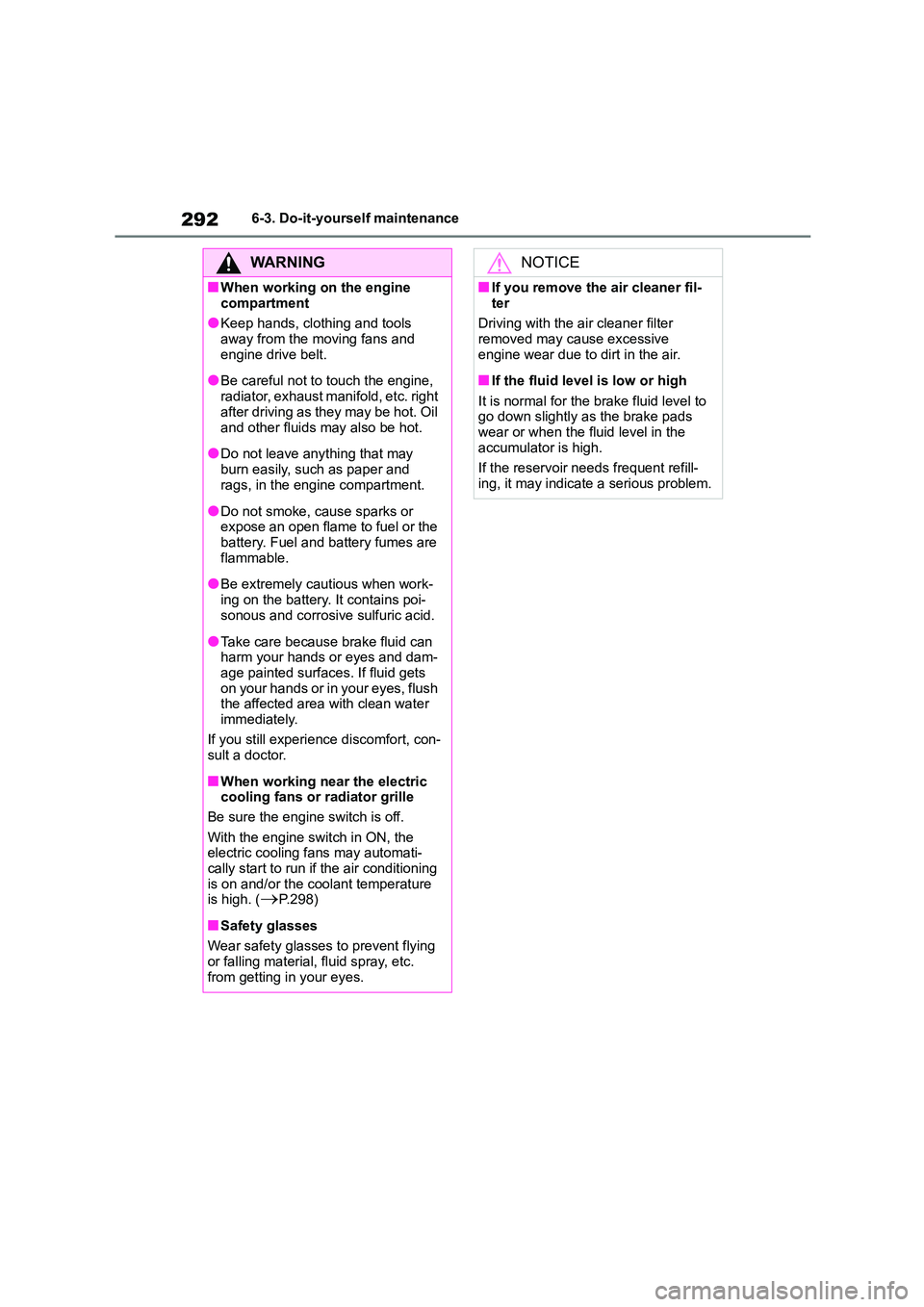
2926-3. Do-it-yourself maintenance
WA R N I N G
■When working on the engine
compartment
●Keep hands, clothing and tools away from the moving fans and
engine drive belt.
●Be careful not to touch the engine,
radiator, exhaust manifold, etc. right
after driving as they may be hot. Oil
and other fluids may also be hot.
●Do not leave anything that may
burn easily, such as paper and rags, in the engine compartment.
●Do not smoke, cause sparks or expose an open flame to fuel or the
battery. Fuel and battery fumes are
flammable.
●Be extremely cautious when work-
ing on the battery. It contains poi- sonous and corrosive sulfuric acid.
●Take care because brake fluid can harm your hands or eyes and dam-
age painted surfaces. If fluid gets
on your hands or in your eyes, flush the affected area with clean water
immediately.
If you still experience discomfort, con- sult a doctor.
■When working near the electric cooling fans or radiator grille
Be sure the engine switch is off.
With the engine switch in ON, the electric cooling fans may automati-
cally start to run if the air conditioning
is on and/or the coolant temperature is high. (P.298)
■Safety glasses
Wear safety glasses to prevent flying
or falling material, fluid spray, etc.
from getting in your eyes.
NOTICE
■If you remove the air cleaner fil-
ter
Driving with the air cleaner filter removed may cause excessive
engine wear due to dirt in the air.
■If the fluid level is low or high
It is normal for the brake fluid level to
go down slightly as the brake pads
wear or when the fluid level in the accumulator is high.
If the reservoir needs frequent refill-
ing, it may indicate a serious problem.
Page 301 of 582
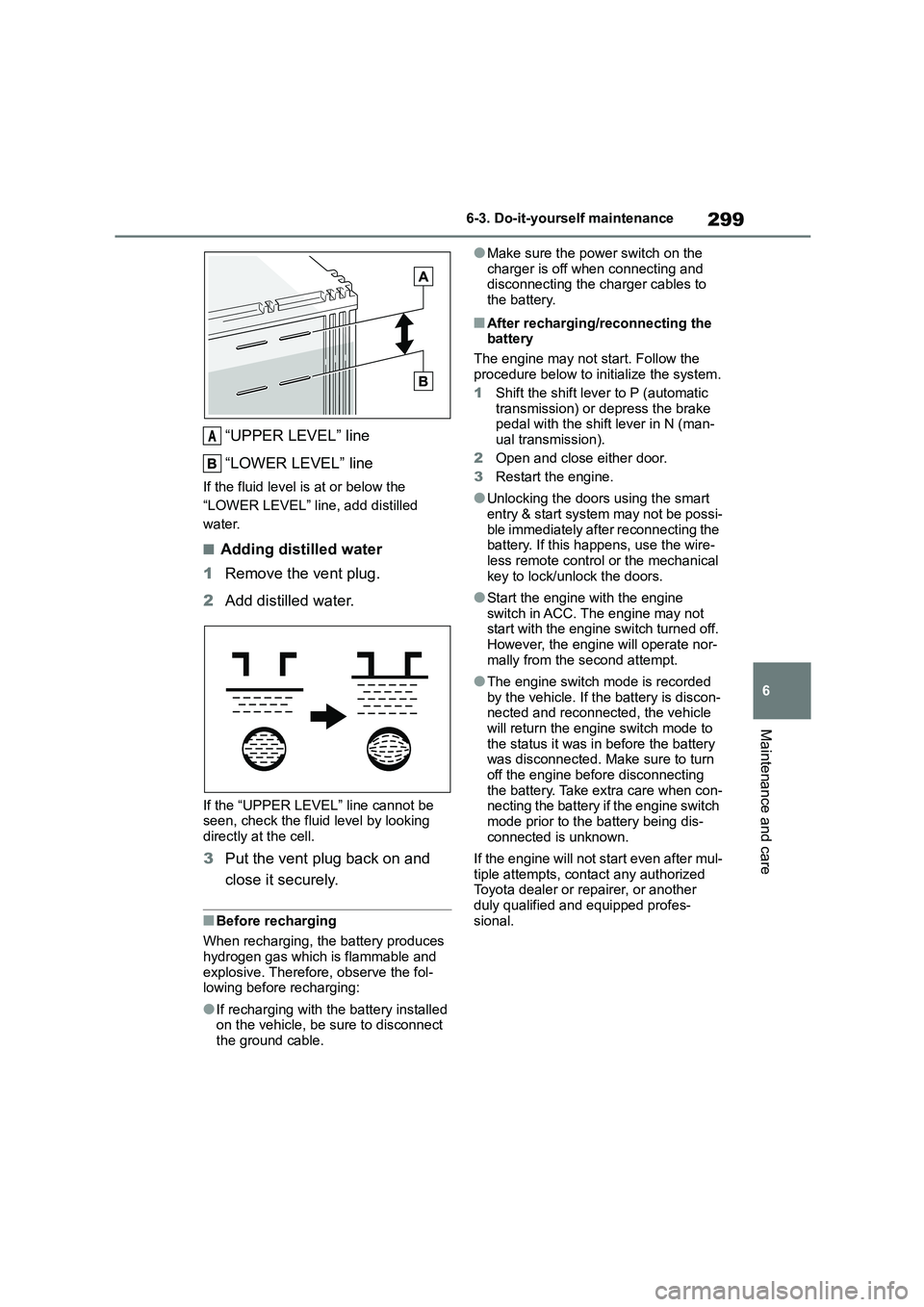
299
6
6-3. Do-it-yourself maintenance
Maintenance and care
“UPPER LEVEL” line
“LOWER LEVEL” line
If the fluid level is at or below the
“LOWER LEVEL” line, add distilled
water.
■Adding distilled water
1 Remove the vent plug.
2 Add distilled water.
If the “UPPER LEVEL” line cannot be seen, check the fluid level by looking
directly at the cell.
3 Put the vent plug back on and
close it securely.
■Before recharging
When recharging, the battery produces
hydrogen gas which is flammable and
explosive. Therefore, observe the fol- lowing before recharging:
●If recharging with the battery installed on the vehicle, be sure to disconnect
the ground cable.
●Make sure the power switch on the
charger is off when connecting and disconnecting the charger cables to
the battery.
■After recharging/reconnecting the
battery
The engine may not start. Follow the
procedure below to initialize the system.
1 Shift the shift lever to P (automatic
transmission) or depress the brake pedal with the shift lever in N (man-
ual transmission).
2 Open and close either door.
3 Restart the engine.
●Unlocking the doors using the smart
entry & start system may not be possi-
ble immediately after reconnecting the battery. If this happens, use the wire-
less remote control or the mechanical
key to lock/unlock the doors.
●Start the engine with the engine
switch in ACC. The engine may not start with the engine switch turned off.
However, the engine will operate nor-
mally from the second attempt.
●The engine switch mode is recorded
by the vehicle. If the battery is discon- nected and reconnected, the vehicle
will return the engine switch mode to
the status it was in before the battery was disconnected. Make sure to turn
off the engine before disconnecting
the battery. Take extra care when con- necting the battery if the engine switch
mode prior to the battery being dis-
connected is unknown.
If the engine will not start even after mul-
tiple attempts, contact any authorized Toyota dealer or repairer, or another
duly qualified and equipped profes-
sional.
A
Page 336 of 582

3347-2. Steps to take in an emergency
Fluid leaks under the vehicle.
(Water dripping from the air con-
ditioning after use is normal.)
Flat-looking tires or uneven tire
wear
Engine coolant temperature
gauge continually points higher
than normal.
Changes in exhaust sound
Excessive tire squeal when cor-
nering
Strange noises related to the
suspension system
Pinging or other noises related to
the engine
Engine missing, stumbling or
running roughly
Appreciable loss of power
Vehicle pulls heavily to one side
when braking
Vehicle pulls heavily to one side
when driving on a level road
Loss of brake effectiveness,
spongy feeling, pedal almost
touches the floor
If you think something is
wrong
If you notice any of the follow-
ing symptoms, your vehicle
probably needs adjustment or
repair. Contact any authorized
Toyota retailer or Toyota
authorized repairer, or any reli-
able repairer as soon as possi-
ble.
Visible symptoms
Audible symptoms
Operational symptoms